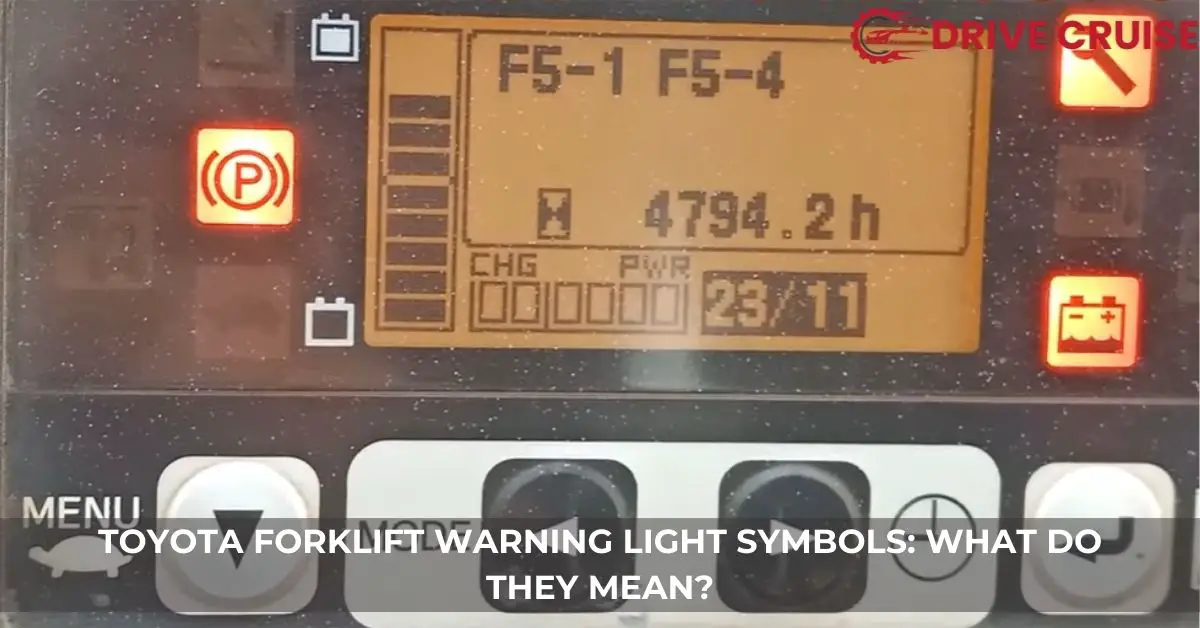Navigating the dashboard of a Toyota forklift isn’t just about keeping an eye on the fuel gauge or the hour meter; it’s about understanding a language spoken through symbols. These warning light symbols are crucial for safe operation, ensuring that we’re aware of our forklift’s health and ready to address any issues before they escalate into major problems.
We’ve all been there, squinting at a flashing light, wondering whether it’s a minor hiccup or a sign of a significant malfunction. It’s easy to feel overwhelmed, but fear not. We’re here to demystify these symbols, turning confusion into clarity. By learning what each symbol means, we can keep our operations running smoothly, maintain our equipment properly, and ensure a safer working environment for everyone involved. Let’s dive in and decode the language of Toyota forklift warning light symbols together.
Understanding Toyota Forklift Warning Light Symbols
Building on the essential knowledge that identifying warning light symbols is crucial for the safe operation of Toyota forklifts, we’re diving into some common ones. Recognizing these symbols promptly ensures not just a safer workspace but also a more efficient maintenance process. Here, we’ll outline several key Toyota forklift warning light symbols and explain their meanings.
- Battery Charge Indicator: This symbol, often resembling a battery, illuminates when the battery’s charge is low. Immediate charging ensures the forklift remains operational and avoids unexpected downtime.
- Engine Oil Pressure: Shown as an oil can, this light indicates low engine oil pressure. Ignoring this symbol can lead to significant engine damage. Checking and topping off the oil as needed is advised if this light appears.
- Temperature Warning: A thermometer submersed in liquid signifies the forklift’s engine or hydraulics are overheating. Operating in this condition might damage the forklift, so it’s crucial to stop the machine and investigate the cause.
- Seat Belt Reminder: Often displayed as a seated individual with a belt, this symbol reminds the operator to buckle up before starting operations. Safety harnesses are vital for preventing injuries.
- Check Engine: This symbol, which may look like an engine, signals various potential engine issues. It’s a prompt for a thorough check-up and possibly expert diagnostics to pinpoint and rectify the problem.
- Brake System Alert: Represented by an exclamation mark inside a circle, possibly with parentheses, this warning light means there’s a problem with the brake system. It could range from low brake fluid to major brake component failure.
Maintenance Tips to Prevent Warning Lights
In our previous discussion, we highlighted the significance of recognizing warning light symbols on Toyota forklifts and how to troubleshoot them effectively. Continuing from there, let’s dive into proactive measures to help prevent these warning lights from illuminating in the first place.
Regular Checks and Balances form the first line of defense against potential issues that could trigger warning lights. For instance, performing daily inspections of fluid levels, such as engine oil, coolant, and hydraulic fluids, ensures that the forklift operates within safe parameters. Similarly, checking tire pressure and condition can prevent mobility-related warnings.
Timely Servicing and Repairs play a crucial role in maintaining forklift health. Adhering to the manufacturer’s recommended service schedule prevents wear and tear from escalating into serious problems. If a forklift starts showing early signs of trouble, such as unusual noises or performance drops, immediate attention can stop issues from worsening.
Battery Care and Maintenance are especially important for electric forklifts. Regular checks on battery terminals for corrosion, ensuring proper water levels, and following correct charging procedures extend battery life and efficiency. This diligence helps avoid warning lights related to battery performance.
Training Operators on Proper Use cannot be underestimated. Educating them about the correct operation techniques and the significance of adhering to weight limits protects the forklift from being pushed beyond its limits, which can cause mechanical stress and eventually trigger warning lights.
Following these maintenance tips not only helps prevent warning lights from coming on but also extends the life of the Toyota forklift, ensuring it remains a reliable and efficient tool in daily operations. Keeping on top of these practices encourages a culture of safety and preventative care within the workspace, contributing to smoother, interruption-free workdays.
Related Posts:


